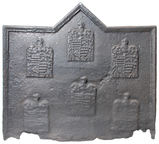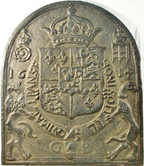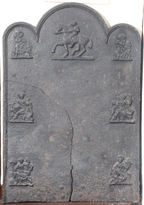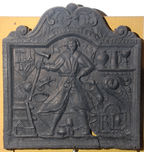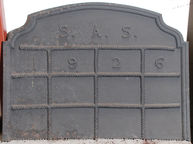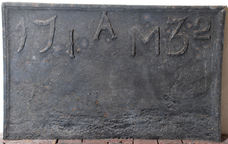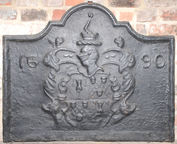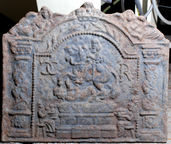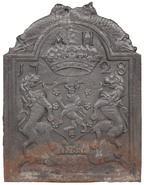-
836
Description: Rectangular with triangular arch; ovolo-moulded edging (top and sides); small stamp of a quartered shield with helm, crest and mantling above the date '1571, initials split either side of shield, repeated six times in two lines of three, the middle stamp of each line higher than the other two.
Notes: The arms may be of the family of Humberston quartered with another; the stamp would have been made specially for the fireback, the date and initials being carved with the arms.
Inscription: I H / 15 71 [repeated 6 times]
Arms: Humberston family
- Decoration tags:
- rectangular with triangular arch (shape)
- ovolo (edging)
- carved stamps
- armorial
- text
Manufactured: in 1571 in the Weald area of England.
Current location: Christchurch Mansion, Ipswich, Suffolk, England.
(part of the Colchester & Ipswich Museums Service museum group)
Citation: Traill, H. D. & Mann, J. S., 1902, Social England vol. III, (London, Cassell), p. 732.
- Attached to series:
- Personal armorial firebacks
- Triangle arch series
-
1137
Description: Arched shape with ovolo-moulded edging; central shield with the English royal Tudor arms and an inescutcheon of a lion rampant, surrounded by a Garter with an incorrect inscription, the shield surmounted by a crown and supported on the dexter side by a dragon and on the sinister side by a greyhound; to the left of the crown, a crowned rose and the the right, a crowned portcullis; above the supporters the date 1614 is split by the shield; below, split by the Garter buckle, initials GB.
Notes: The arms are of Henry VII or Henry VIII, the inescutcheon probably representing a marriage to an heiress, but are anachronistic as the date was in the reign of James I (and VI). The initials GB are believed to relate to Gilles or Georges Boniver, who worked at the foundry at Theux, near Liège, and whose initials appear on several firebacks. The fireback is thought to be a 19th-century copy.
Copies of this fireback are known.
Inscription: 16 14 / HONI SOIT IL QVIMAL I PANSE / G B
Arms: English royal Tudor with an inescutcheon of a lion rampant
- Decoration tags:
- rounded arched (shape)
- ovolo (edging)
- whole carved pattern
- heraldic
- armorial
- royal
- text
Manufactured: in 1614 probably at Theux Furnace in the Franchimont area of Belgium.
Current location: M-Museum Leuven, 28-30 Leopold Vanderkelenstraat, Leuven, Brabant, Belgium.
(part of the Leuven Museum museum group)
-
427
Description: Rectangular with three sem-circular arches on top, the middle arch higher and wider than the others; ovolo-moulded edging (top and sides); top centre, equestrian figure stamp; six small stamps of iconic figures down the sides, arranged in two columns.
Notes: An unusual fireback with stamps about 90mm high; the stamps are likely to have been cast from brass or iron mantelpiece ornaments, popular in the Victorian period. Formerly part of the J. H. Every collection.
- Decoration tags:
- rectangular with three arches (shape)
- ovolo (edging)
- carved stamps
- pictorial
- animals
- humans
Manufactured: in the 19th century in England.
Current location: Anne of Cleves House, Southover High Street, Lewes, East Sussex, England.
Museum number: 1944.24.089 (part of the Sussex Archaeological Society museum group)
- Attached to series:
- Ornament stamp firebacks
- Metalware stamp firebacks
-
429
Description: Arched rectangular shape with symmetrical floral scrolls on top; three horizontal plank lines; ovolo moulding all round edge of main panel; inscription along top edge of panel; central figure of a bearded man wearing knee-length coat, belted at waist, and holding a sledge hammer in his right hand, his left arm akimbo; both feet pointing to his right; various ‘tools’ of his trade arranged about him; (clockwise from top left) shield, the quarters containing a masonry hammer, a firedog, a weight, and a pair of pincers; the date split on either side of his head; a floral console supporting a shelf bearing a flagon, a tankard and a goblet; a fireback bearing the letters RL and a diamond shape; from the top of the fireback a dog leaping up at its master; between the man's legs a long-handled ladle, a weight and a cooking pot; a ringer, used to pull slag off molten iron; part of the elevation of a blast furnace, with wooden framework, casting house, and flames issuing from the top; an ore basket, wheelbarrow and a charcoal clamp
Notes: The 'Lenard' fireback; a much-copied plate. Items relating to the founder's working life are displayed to the left of the figure, those to the right reflecting his domestic life. Its individualistic design and naïve figuration are the key to identifying a distinct group of firebacks, all probably made at Brede. A pastiche of this fireback also exists (no. 668), with which it is sometimes confused.
Copies of this fireback are known.
Inscription: RICHARD LENARD FOVNDER AT BRED FOVRNIS [each D is reversed] / 1636 / RL
- Decoration tags:
- rectangular with round arch (shape)
- ovolo (edging)
- whole carved pattern
- planklines
- pictorial
- historical
- text
- animals
- humans
- objects
Manufactured: in 1636 at Brede Furnace in the Weald area of England.
Current location: Anne of Cleves House, Southover High Street, Lewes, East Sussex, England.
Museum number: LH000.906 (part of the Sussex Archaeological Society museum group)
Citation: Anon., 30 Dec 1911, 'Sussex Backs and their Story', The Ironmonger.
Citation: Dawson, C., 1903, 'Sussex Iron Work and Pottery', Sussex Archaeological Collections, 46, pp. 1-54.
Citation: Gardner, J. S., 1898, 'Iron Casting in the Weald', Archaeologia, 56, 1, pp. 133-164.
- Attached to series:
- Brede group
- Personal firebacks
-
440
Description: Rectangle joined to low arch with cyma recta curves; ovolo-moulded edging (top and sides); grid of twelve rectangles (4 columns of 3) with twisted rope borders; initials in arch, date in top line of rectangles.
Notes: A fireback cast specially to mark the 60th anniversary of the Sussex Archaeological Society, and donated to the society by Mr John Every.
Inscription: S.A.S. / 1926
- Decoration tags:
- rectangular with canted top corners and round arch (shape)
- ovolo (edging)
- simple stamps
- individual letters
- individual numbers
- text
- objects
Manufactured: in 1926 at Phoenix Foundry, Lewes in the Weald area of England.
Current location: Anne of Cleves House, Southover High Street, Lewes, East Sussex, England.
Museum number: 1944.24.093 (part of the Sussex Archaeological Society museum group)
- Attached to series:
- Miscellaneous stamp firebacks
-
447
Description: Rectangular; ovolo-moulded edging; inscription across top of plate, numerals, except '2', larger than letters, 'A' raised above 'I' and 'M'.
Notes: A late, and rather unsophisticated example of the use of individual stamps.
Inscription: 17 IAM 32
- Decoration tags:
- rectangular (shape)
- ovolo (edging)
- individual letters
- individual numbers
- text
Manufactured: in 1732 in the Weald area of England.
Current location: Anne of Cleves House, Southover High Street, Lewes, East Sussex, England.
Museum number: LH000.950 (part of the Sussex Archaeological Society museum group)
- Attached to series:
- Date & initials firebacks
-
458
Description: Fragment; bottom left corner missing; rectangular; ovolo-moulded edging; initials split by date across top of plate.
Notes: The numerals show the transition between archaic and modern type styles. Formerly part of the J. H. Every collection.
Inscription: S 1753 W
- Decoration tags:
- rectangular (shape)
- ovolo (edging)
- individual letters
- individual numbers
- text
Manufactured: in 1753 in the Weald area of England.
Current location: Anne of Cleves House, Southover High Street, Lewes, East Sussex, England.
Museum number: LH000.922 (part of the Sussex Archaeological Society museum group)
- Attached to series:
- Date & initials firebacks
-
462
Description: Rectangular with an arched rectangular style arch linked by symmetrical concave curves; ovolo moulding (top and sides); shield, helmet, crest and mantling of the family of Baker, of Mayfield, quartered with Farnden, of Sedlescombe: Quarterly, 1st and 4th, Argent, a tower between three keys erect sable (Baker); 2nd and 3rd, Purpure, a chevron vairy Or and gules, between three leopards’ faces Or (Farnden); crest (Baker): on a tower sable an arm embowed in mail holding in the hand a flint-stone proper. Date split by mantling.
Notes: A carved armorial on a plain, edged base board. John Baker (1644-1723) married Ruth, daughter and co-heiress of Peter Farnden, in 1663; she died in 1691. During their marriage the Farnden arms, would have been borne as an escutcheon of pretence in the centre of the arms of Baker, and not quartered with those of her husband until after her death. The date, 1690, is therefore spurious and would have been added to a later copy of a mid-18th century armorial fireback (see no. 16).
Inscription: 16 90
Arms: Baker of Mayfield quartering Farnden of Sedlescombe
- Decoration tags:
- rectangular with canted top corners and round arch (shape)
- ovolo (edging)
- carved pattern panels
- individual numbers
- armorial
- text
Manufactured: in the 19th century in the Weald area of England.
Current location: Barbican House, High Street, Lewes, East Sussex, England.
(part of the Sussex Archaeological Society museum group)
- Attached to series:
- Ironmasters armorial series
- Personal armorial firebacks
-
464
Description: Arched rectangular shaped central panel, bead edging (top and sides), pedestal bearing a supine male figure with headband being trampled by a horse, facing left, mounted by a rider with long hair, facing to the front; on each side of the plinth is a seated figure with a basket of fruit; the inscription is split either side of the horse; arched rectangular shaped border, fillet edging, on each side a Solomonic column with vine decoration; in the arch, symmetrical parallel curved lines intertwined beneath a crown; on top of each shoulder of the plate a female figure in repose.
Notes: The equestrian figure is derived from the statue of Charles II erected in Stocks Market, London, in 1672. Originally to be of Jan Sobieski, later king of Poland, riding down a Tatar, it was altered to represent Charles, and the Tatar’s face was changed to that of Oliver Cromwell; the statue attracted a fair degree of derision. The 'CC' monogram is likely to be for Charles and Catherine (of Braganza). The statue is now at Newby Hall, near Ripon, North Yorkshire. Another version (no. 280), probably by the same pattern-maker, is dated 1674 and has altered initials.
Copies of this fireback are known.
Inscription: CC [interlocked, and the first reversed] R
- Decoration tags:
- 'Dutch' (shape)
- ovolo (edging)
- whole carved pattern
- individual letters
- pictorial
- historical
- text
Manufactured: in the mid- to late-17th century in England.
Current location: in private hands, Little Horsted, East Sussex, England.
- Attached to series:
- Carolean 'Dutch' series
- Commemorative firebacks
-
870
Description: Arched rectangular shape with ovolo-moulded edging and narrow extensions to sides; central shield bearing arms with lion rampant supporters and motto scroll beneath; above, a marquesal coronet; date split between top corners; inserted initials above coronet; on top of arch, two downward facing dolphins with tails entwined.
Notes: The arms are of the family of Henry Pierrepont, marquess of Dorchester and earl of Kingston-upon-Hull, of Thoresby Hall, Nottinghamshire (blazon: argent semi of cinquefoils gules, a lion rampant sable), with the motto: Pie Repone Te (Place yourself piously), a pun on the name, Pierrepont. Confusingly, the marquisate of Dorchester was created twice for members of the same family. In 1645 it was created for Henry Pierrepont, 2nd earl of Kingston-upon-Hull, becoming extinct on his death without surviving male issue in 1680. It was created again for Evelyn Pierrepont, the 5th earl of Kingston in 1706 who was subsequently elevated to the dukedom of Kingston in 1715. The original casting may therefore have dated to between 1645 and 1680 or between 1706 and 1715. The initials may be related to the Halls, the 2nd Duke of Kingston's mother's family, and were probably added with the date in 1728. Woolley & Wallis auction, Salisbury, 8 Jul 2014, lot 518 (£250); Lyon and Turnbull auction, Edinburgh, 1 Sep 2021, lot 10.
Copies of this fireback are known.
Inscription: A H / 17 28 / PIE REPONE TE
Arms: Pierrepont, Marquess of Dorchester
- Decoration tags:
- rectangular with round arch (shape)
- ovolo (edging)
- whole carved pattern
- individual letters
- armorial
- text
Manufactured: in 1728 in England.
Current location: not known.
- Attached to series:
- Personal armorial firebacks
- Pierrepont series
